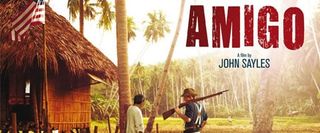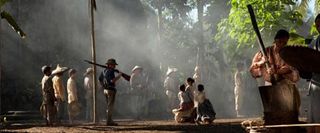Interview: John Sayles Scales Down The War Movie With Amigo

A war movie made for $1.5 million--is that even possible? Certainly not in terms of the Hollywood fare we’re used to, but John Sayles has never made your average Hollywood fare. The director of Matewan, Passion Fish and Lone Star has brought a tight, low-budget focus to the war movie with Amigo, a story set during one of the most overlooked American conflicts, the Phillippine-American war.
Sayles narrows the story down to a single baryo and what happens when US troops take over. Lt. Compton (Garret Dillahunt) is the man in charge and names Rafael (Joel Torre), the village leader, his chief liaison to the people, as Rafael’s declared his opposition to the Spaniards. Trouble is, after the invasion, Rafael’s son runs off to join his uncle and the local band of rebels. While Rafael works to both appease the intruding Americans and keep his loved ones safe, Lt. Compton is also fighting to establish a congenial relationship with the villagers and obey the orders of the callous Col. Hardacre (Chris Cooper).
Well-versed in making movies on a shoestring, Sayles had the small bank account in mind from day one and considered it when writing his script and, of course, while bringing the tale to life. Sayles opted to cross the globe and shoot on location in the Philippines where he teamed up with local filmmakers and actors to create a piece with a modest price tag, albeit a strong degree of authenticity. In honor of Amigo’s August 19th release, Sayles took the time to talk about the book his film is based on, his experience working overseas, an unusual hurdle in the editing room and much more.

For a while you were delivering a feature just about every year. Why take some more time between this and Honeydripper? Basically because we don’t have the months to do it in a year. [Laughs] I certainly could write and I could probably even direct a movie every year. Getting it out and doing the publicity for it takes a lot longer than that. This is a movie that we made I think almost two years ago and it’s finally coming out in the states; it just came out in the Philippines. Things take a long time now. Certainly as a screenwriter for hire, what I’m seeing is people are a lot more cautious before they give the green light to a project. Fewer projects, certainly features, are getting made in Hollywood and I think once you get past the first time filmmakers making things on a home movie camera, it’s really hard to get an independent film made and then after you get it made, there may not be any distributors around. It can be a longer campaign to find a distributor for a film than to actually make it.
It’s pretty unusual that we see an independent war movie as opposed to one with tons of explosion, famous faces and extensive costumes. Do you think that might have scared people away? No, you know, I don’t think people get scared away. I think they just look at the movie and they say, ‘Do we know how to distribute this movie and make money on it?’ And right now, quite honestly, everybody, certainly the studios, have kind of circled the wagon and they’re only thinking two or three kinds of films. They’re making slacker comedies, cheap horror movies and big comic book adventure movies. Independents are making all kinds of movies, but there’s really not an independent movie business anymore. It’s very very rare that an independent distributor will front the money to make a movie, so they’re just looking at everything that comes out and kind of guessing and saying, ‘What do we think we can put out here with very little advertising and make our money back and make some profit on?’ So, you know, it can take a long time because everybody’s so cautious. And also a lot of companies go out of business. Every time we come out with a new movie, about half the companies that existed the last time are gone. The people are the same, but the companies have new names.
Is part of the reason you chose to make Amigo so it’d stand out amongst the options? I only know of maybe one other film on the Philippine-American War. I think this is the third American movie ever made about the Philippine-American War. It’s one of the reasons I was interested in doing it, quite honestly. But usually, when America wins a war we celebrate it with lots of media, with lots of movies and I think there was a little bit of shame on the part of America, even at the time, but certainly in retrospect. There’s nothing very glorious about this war. It’s got a nasty guerilla war, we out-gunned them and what are we doing taking over somebody else’s country? That’s not an American thing to do. And we didn’t do it very much after that, but there was this brief little period where America decided it wanted to be an imperialist country like all the other European powers and started snatching up territories, and didn’t do it very well and weren’t too comfortable with doing it. So I think this is kind of a unique period and it’s one of the reasons I thought that, ‘Geez, I’d want to make a movie about something that really hasn’t been dealt with in American popular culture.’

I read your screenplay was based on a book. Did all of your information come from that or did you need to do additional research? I wrote a novel that just came out a couple months ago called A Moment in the Sun, which is a giant historical novel, it’s like over 900 pages long, and part of the story takes some of the characters into the Philippines for the Philippine-American War. So I had basically done all the research I needed to make Amigo for the novel and while I was doing that research, the part of it in the Philippines, I got talking with Joel Torre who’s the lead actor in Amigo about the Philippine movie business and realized, ‘Oh, here’s a place that has a vibrant movie business.’ They make a lot of TV and movies, they have a lot of really talented actors and crew people. The little bit of money we had left from making other independent movies, [laughs] we could come here and make a pretty ambitious movie for not much money. Amigo cost about $1.5 million, we had an all Filipino crew, a terrific crew, and I was able to do something on a fairly large scale, but certainly not for what it cost in the United States.
CINEMABLEND NEWSLETTER
Your Daily Blend of Entertainment News
When you’re writing a screenplay, does that price tag come into play? Do you ever hold yourself back because you don’t know if you’ll be able to fulfill a visual financially? Yeah, you do a little of it when you’re writing early drafts. You write a period thing and you say, ‘No, we’re not going to be able to do a battle with artillery because either the special effects or actually making this gun is going to cost us too much.’ Amigo is on a village level. They’re on a little baryo in Northern Luzon during the war and we could build that baryo. All it took was weave the thatch and bamboo, and most of the construction was done with bolos and not power tools, and shoot 360 and it didn’t cost us too much. We bought a village’s rice crop and most of the people in the village are the extras in the movie. I wrote that to be cheap. I also always do a last draft after we’ve scouted the place and know where we’re going to shoot, which is what I call a practical draft, where there may still be one or two scenes that are going to cost us like a third of the budget to do a three-page scene, and I’ll have to rethink those sometimes just because the scale of what we want to do turned out to be too expensive. This is a movie that has three horses in it. It’s not a movie that has a cavalry charge.

When does your DP come in? Did you express all of this to her? On this movie I worked with Lee Meily. She’s probably the premier cinematographer in the Philippines. We talked quite a bit beforehand. I storyboarded the entire movie, so I kind of built the village in a computer and moved little figures around and showed her the pictures, and then we went to the set. We also shot the movie on the RED camera, which is a digital camera, the first time I’ve worked with that, but a camera that Lee had worked with before. She knew its attributes and so we could talk about, ‘Oh, we can’t shoot in that direction at that hour because sun will be too bright. Digital can’t handle that brightness, but between four o’clock and six o’clock we can shoot in that direction, so let’s do that.’ You really work with your DP very very closely. And then she’s a great boss. Her team of guys that work under her were very efficient. We had six weeks to shoot, which is a luxury for me because I’ve been making movies in four and fives weeks, but we pretty much stayed right on schedule and part of that was because all the work that I did with Lee and that she did with her guys to plan things so that the equipment would be exactly where we needed it when we moved from one little part of the location to another.
Fast-forwarding quite a bit, you also edited Amigo. You do that often with the films you direct, but here is that a decision you made because you like to edit or did it stem from the financial strain and being able to knock another job off the list? For me, it’s really the third draft of the storytelling. I’m a novelist and I wouldn’t have somebody else come in and write the third draft of my novel after I’d done the first two. You’re really still telling the story, you’re still working with the actors, you’re making vital storytelling decisions and it’s something I like doing. In this case, because half the dialogue is in Tagalog, which I don’t speak, I was both directing the actors and cutting the film as an editor in a language that I don’t understand every word. I saw the scene because I wrote it before it was interpreted, so I’m editing by emotion and the focus of the actor and the feeling of what the actors are doing and then my associate editor, Mario Ontal, understands Tagalog so he would tell me when, ‘Oh, you’ve got somebody repeating the same word on the cut,’ you know, things that I might miss. But I cut the movie and I didn’t put the subtitles on until I pretty much had a final cut of the movie. Actually, I prefer it without subtitles. [Laughs] It’s more emotional in some ways without the subtitles.

So, now you’re enjoying the release of Amigo after all this time, but do you have anything else in works? Yeah, I’ve written a movie I’d like to direct about Julius and Ethel Rosenberg who were executed in the 50s for espionage. I’ve written that script and we’re hoping to raise money for that and I’d doing the various writing for other people. I’m writing screenplays for other people for both television and movies, which is how I make a living. And you just never know with those, if they’re going to get made or if things get made, if they’re going to turn out well, but your job is to push the project forward and get them a green light so that they can do the next part of it which is actually making the movie.
How about some of those other types of films you spoke about before? Any chance you’d go for one of those big budget topics that have been used and abused, but put your own spin on it? I have no problem working with studios. I wouldn’t want to do it unless I had final casting control, and they don’t just hand that out, [laughs] to anybody who hasn’t recently gave them several hundred million dollars, so it’s unlikely to happen, but yeah, there’s mainstream Hollywood movies that I like and think are really well made. But those jobs are few and far between these days so, as I said, I don’t think it’s likely. Lately my favorite movies have all been animated movies. I think that’s where the best writing as far as features is going is in the animated movies, some of them the most imaginative stuff. And then some TV series. There’s really good writing going on in those. So, yeah, I’m not closed off to anything, but you get spoiled working on independent movies and getting final cut and getting to cast who you want to cast and it’s hard to go backwards, even if you make more money, and all of a sudden be told who you have to cast and, ‘Oh, we’re going to change the meaning of this scene by recutting it.’ It’s almost impossible to go backwards.
Staff Writer for CinemaBlend.
Most Popular




